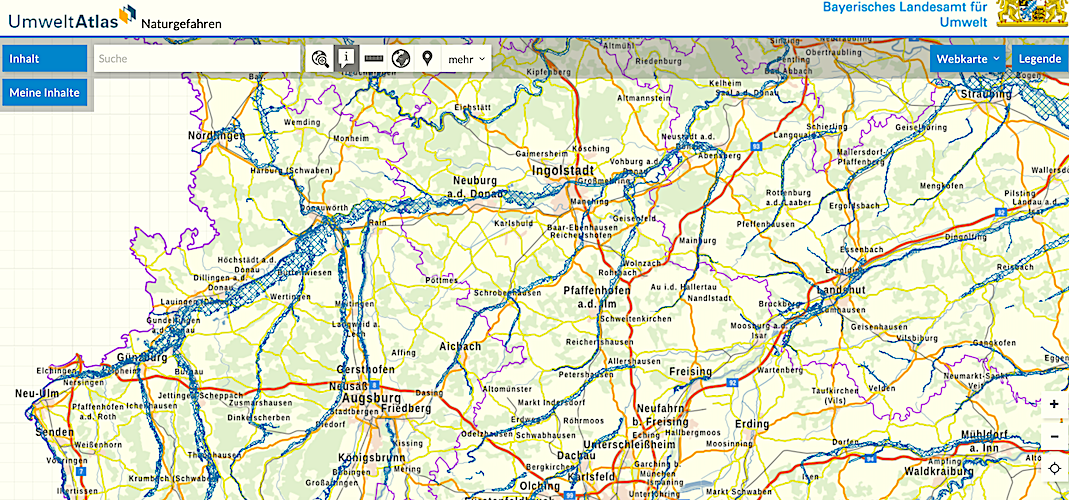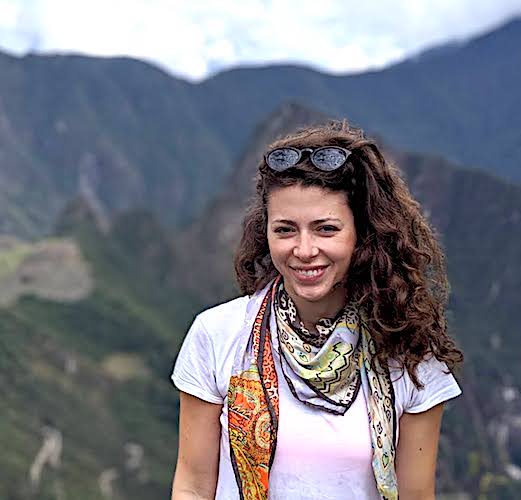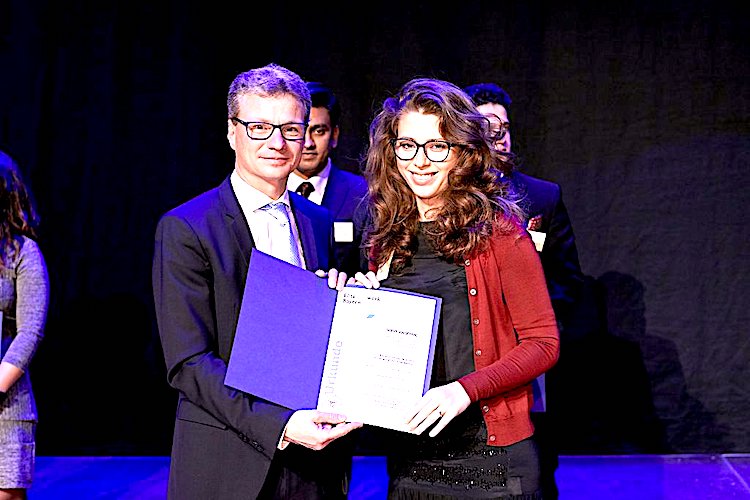The Master of the Model

The Bavarian Umweltatlas shows floodplains shaded in blue, especially many along the Danube. For this purpose, data from LARSIM, among others, are included here (https://www.umweltatlas.bayern.de/startseite/)
Snow, hail, rain - on average, around 940 millimeters of precipitation fall in Bavaria every year, which means around 66 billion cubic meters or 66 trillion liters of water for the entire Free State. When it thaws in the spring or rains heavily in the fall, the risk of flooding and highwater increases: Ivana Jovanovic-Buha knows such water data inside out and knows much more about water levels in Bavaria. The computer scientist has been working on Bavaria's hydrology since 2018. She is currently using mathematical methods and the high-performance computers of the Leibniz Supercomputing Center (LRZ) to check the software and tools that the State Office for the Environment (LfU), for example, uses to create its flood forecasts or plan water management measures. The aim is to make these forecasts even more detailed and accurate, but to do so, the models on which they are based must be revised and the statistical uncertainties they contain quantified: "There are many uncertainties in hydrological models," explains Ivana. "But there are many measured values for most points, and with these we can minimize the uncertainties step by step."
Computing for better software and applications
This is not a task for geologists or hydrologists; model maintenance is the job of computer scientists with a penchant for mathematics - scientists like Ivana, in other words: she is working for her PhD at Prof. Dr. Hans-Joachim Bungartz from the Chair of Scientific Computing at the Technical University of Munich (TUM), where her subject combines mathematics and computer science. With her work, Ivana quantifies statistical uncertainties of complex models using advanced numerical algorithms; she then optimizes the algorithms so that super and other high-performance computers run them faster, more efficiently, and more fluently.
So what, in this case, gives Bavaria and its residents more accurate flood forecasts and the LfU better, more modern software, is basically a special finger exercise for equations and formulas for the young scientist. Hydrology is only one field to which her knowledge can be applied, she could just as easily match and process data on engines, other natural sciences, or from medicine. "I like working on things that are real, practical and useful," she says with a laugh. "Then I don't put things off, I can be creative, develop solutions, plus then I like to read up on theories from research disciplines like hydrology and try to develop new models." It is this mix of theory and practice that Ivana hopes to achieve after her doctorate – her thesis should be ready by summer 2023 at the latest. It is more likely that she will not seek them in academia, but will initially prefer to bring them into companies or startups that are similarly close to everyday and technical issues as the LfU or the Bavarian State Ministry for the Environment and Consumer Protection. Environmental topics are exciting, but the computer scientist also feels well equipped to deal with technical issues.
Her education is broad-based: After completing her bachelor's degree at the University of Electrical Engineering in Belgrade – for her thesis she worked on developing a model for automatic lung cancer detection and classification – she came to Germany and enrolled in Computational Science and Engineering at TUM, it’s a mixture between applied mathematics, computational science and technic. "For the master's, I wanted to go to Sweden or Germany," she says. " Because of this mix of research areas TUM was high on the wish list for Germany , and for my husband it was the first choice, so I ended up here."
Explaining complex correlations in an understandable way
Ivana already stands out positively with her performance in the first master's semester and is accepted into the Bavarian Graduate School of Computational Engineering (BGCE). Part of this elite programme is participation in an industrial project at Zeiss. "Participating in the BGCE programme was an important turning point for me," Ivana says. "It gave me a better insight into scientific topics, brought me many new contacts and connections, and I became a recipient of the Deutschland-Stipendium. Last but not least, the programme fostered the relationship with Professor Bungartz's chair, where I'm doing my PhD now." For her master thesis, she was busy with artificial intelligence methods at Siemens and developed deep learning models for evaluating 3D point cloud data sets – a technique needed for robotics and autonomous driving, for example, to provide machines with orientation points and scenarios for their paths and tasks.
At the Chair of Scientific Computing, she now teaches scientific programming and simulation as a lecturer, but can research her real topic, the quantification of uncertainties in complex models, in hydrology projects for the LfU. "Research and teaching are not always easy to reconcile, but the chair is well organized, we get clearly outlined tasks and thus gain freedom for research," she says. "I like teaching, when I explain topics like applied mathematics or numerical methods to others, I still learn myself, plus I practice expressing myself in a way that is understandable." The training is working. Ivana uses graphs and pictures to explain her tasks. She gestures as she speaks, applies theory to everyday things, explains in a lively, spirited manner, and humor often flashes through the descriptions. Clearly, Ivana likes what she does. "She is able to illustrate complex topics and relationships and explain them in a comprehensible way," says Wolfgang Kurtz, a geo-ecologist with a doctorate who, as project manager at the LRZ, worked with Ivana Jovanovic-Buha for a long time on the Bavarian hydrology project HydroBITS and supervised bachelor's and master's theses with her. He particularly emphasizes the expertise, the quick grasp and her engagement, which went far beyond her tasks: "A very nice cooperation, because we really worked together and without silo thinking on the hydrology topics, this was not a pure community of convenience, but always took place in a very professional, trusting and human extremely pleasant atmosphere," says Kurtz. "And Ivana always brought herself and her experience to our, that is, the LRZ topics as well, for example, advancing the visualization of hydrological data using dashboards or building data analysis tools."
Model, validate, and constrain uncertainties
The aim of HydroBITS was to analyze and optimize existing IT structures at institutions of water management in Bavaria and at the Hochwasser-Nachrichtendienst. For this purpose, the models for the simulations, which result from information such as water levels, precipitation, moisture in the soil, but also the further processing of results as well as the data management were reviewed and improved. Ivana's tasks focused on the "Large Area Runoff Simulation Model", or LARSIM, a hydrological model or program that collects and provides data on Bavaria's water balance and environment and updates it on an hourly basis. LARSIM is used by the flood information service to prepare situation reports and warnings, and by the LfU to plan measures. With other tools, graphics or three-dimensional maps of Bavaria are created from this data, making developments visible, such as the effects of heavy rain on rivers, streams, municipalities. “My work involves experimenting with and developing new algorithms for efficient quantification of uncertainty in complex models, for HydroBITS I do so with environmental or hydrological models. In order to achieve this, I really on numerical techniques, such as different mathematical expansions of the quantity of interest and sparse-grids", Ivana explains.
How water is distributed in larger areas such as Bavaria is represented in hydrological models. To do this, a wide variety of information is collected, such as precipitation, groundwater levels, and data on soil qualities or landscapes. Not all of these parameters can be accurately measured or estimated. How much rain falls cannot be recorded at every point in Bavaria. To compensate for such gaps in knowledge or inaccuracies, researchers often have to work with average and approximate values – the reason for the uncertainties of a model. "I treat the underlying model as a black box and assume some probability distributions over model parameters. Then I use lots of samples to validate my assumptions and enhance my understanding of the model and different relationships between its parameters. In this way, I can better isolate uncertainties and improve the result step by step”, Ivana explains. "The future is certainly unpredictable, but it's quite likely that the weather or precipitation will develop similarly to past years." By slightly altering measured data or criteria, Ivana creates variants of a model. She leaves this computational work to the CoolMUC cluster at LRZ, which sometimes works for her for 25 to 48 hours. And the differences in the results in turn make deviations obvious – these can then be quantified and the algorithm optimized accordingly. To complement and maintain classic models such as LARSIM, the researcher also works with so-called data-driven models, for which smart systems or neural networks process information, for example about the water balance and landscapes of Bavaria, read patterns from it, and use these to provide insights or forecasts.
Project HydroBITS is in its final phase and is expected to be completed by March 2022. The simulations resulted in a forecasting tool with a clear dashboard and efficient data streams. Along the way, Ivana gained the knowledge that she will now process, discuss and evaluate for her doctoral thesis. She finds relaxation while jogging and hiking, also while cooking or listening to music. She favors classical or mainstream jazz. Her future is open, but it is clear that she will one day combine family and work. She takes her cue from Karen Willcox, an aerospace engineer with a doctorate and post-doctorate: she holds a leadership position as director of the U.S. Oden Institute for Computational Engineering and Science, has made a name for herself as a scientist and is also a mother. "Definitely a role model for me," Ivana says. From this perspective, we will be reading and hearing a lot more about Ivana. (vs)


Ivana Jovanovic-Buha in the mountains and with Bernd Sibler, Bavarian Minister for Science and Art, at at the award and admission to the elite BGCE programme
More young researchers and specialists you should know:
• Elizabeth Mayer, LRZ: Media and Computer Science
• Amir Raoofy, TUM: Compouter Science and Supercomputing (HPC)
• Mohamad Hayek, LRZ: Computer Science and Datatransfer
• Sophia Grundner-Culemann, LMU, cryptography
• Bengisu Elis, TUM, supercomputing and programming models
• Daniëlle Schuman, LMU, quantum computing
